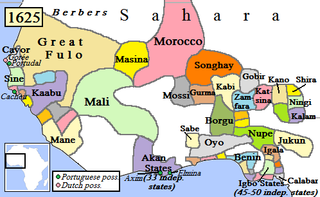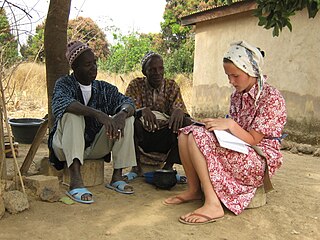Related Research Articles

The national flag of Guinea was adopted on 10 November 1958, with the publication of the country's first Constitution.

Fouta Djallon is a highland region in the center of Guinea, roughly corresponding with Middle Guinea, in West Africa.

The Baga are a West African ethnic group who live in the southern swampy lands of Guinea Atlantic coastline. Traditionally animist through the pre-colonial times, they converted to Islam during the mid-eighteenth century under the influence of Muslim Mandé missionaries. Some continue to practice their traditional rituals.

Kouroussa or Kurussa is a town located in northeastern Guinea, and is the capital of Kouroussa Prefecture. As of 2014 it had a population of 39,611 people. A trade center and river port from at least the time of the Mali Empire, Kouroussa has long relied upon its position near the upstream limit of navigation of the Niger River to make it an important crossroads for people and goods moving between the Guinea coast and the states of the western Soudan and Niger River valley. The town and surrounding area is a center of Malinke culture, and is known for its Djembe drumming tradition.

The Kaabu Empire (1537–1867), also written Gabu, Ngabou, and N'Gabu, was an empire in the Senegambia region centered within modern northeastern Guinea-Bissau, larger parts of today's Gambia; extending into Koussanar, Koumpentoum, regions of Southeastern Senegal, and Casamance in Senegal. The Kaabu Empire consisted of several languages, namely: Balanta, Jola-Fonyi, Mandinka, Mandjak, Mankanya, Noon (Serer-Noon), Pulaar, Serer, Soninke, and Wolof. It rose to prominence in the region thanks to its origins as a former imperial military province of the Mali Empire. After the decline of the Mali Empire, Kaabu became an independent Empire. Kansala, the imperial capital of Kaabu Empire, was annexed by Futa Jallon during the 19th century Fula jihads. However, Kaabu's successor states across Senegambia continued to thrive even after the fall of Kansala; this lasted until total incorporation of the remaining Kingdoms into the British Gambia, Portuguese and French spheres of influence during the Scramble for Africa.

Pular (𞤆𞤵𞤤𞤢𞤪) is a Fula language spoken primarily by the Fula people of Fouta Djallon, Guinea. It is also spoken in parts of Guinea-Bissau, Sierra Leone, and Senegal. There are a small number of speakers in Mali. Pular is spoken by 8.5 million Guineans, about 55% of the national population. This makes Pular the most widely spoken indigenous language in the country. Substantial numbers of Pular speakers have migrated to other countries in West Africa, notably Senegal.
The Almamyate of Futa Toro (1776-1861) was a West African theocratic monarchy of the Fula-speaking people in the middle valley of the Senegal River. The region is known as Futa Toro.

The Imamate of Futa Jallon or Jalon was a West African theocratic state based in the Fouta Djallon highlands of modern Guinea. The state was founded around 1727 by a Fulani jihad and became part of French West Africa in 1896.

The Yalunka, or Dialonké, are a Mandé-speaking people who were one of the original inhabitants of the Futa Jallon, a mountainous region in Guinea, West Africa. The Yalunka people live primarily in Guinea, particularly in Faranah, while smaller communities are found in Kouroussa. Additional Yalunka are also located in northeastern Sierra Leone, southeastern Senegal, and southwestern Mali.
Ahmadou, was one of the last Almamis of the Fula Imamate of Futa Jallon, in the Futa Jallon region of today's Guinea.

The following outline is provided as an overview of and topical guide to Guinea:
Porédaka is a town and sub-prefecture in the Mamou Prefecture in the Mamou Region of Guinea. It is located roughly 55 kilometres (34 mi) northeast of Mamou. The Battle of Porédaka took place here on 13 November 1896, during which French colonial troops decisively defeated the last forces of the Imamate of Futa Jallon, after which Futa Jallon was annexed into Senegambia.
The Jakhanke -- also spelled Jahanka, Jahanke, Jahanque, Jahonque, Diakkanke, Diakhanga, Diakhango, Dyakanke, Diakhanké, Diakanké, or Diakhankesare -- are a Manding-speaking ethnic group in the Senegambia region, often classified as a subgroup of the larger Soninke. The Jakhanke have historically constituted a specialized caste of professional Muslim clerics (ulema) and educators. They are centered on one larger group in Guinea, with smaller populations in the eastern region of The Gambia, Senegal, and in Mali near the Guinean border. Although generally considered a branch of the Soninke, their language is closer to Western Manding languages such as Mandinka.
The Batè Empire was a pre-colonial state centred on Kankan in what is today Guinea. It was founded in the 16th century by migrants from the Sahel, Mandinka and Soninke people, as an Islamic merchant state. The founders settled on the left shore of the Milo River in Upper Guinea, and made Kankan their capital. They practiced a devout form of Islam and were known for their piety. In the first half of the eighteenth century, Batè leaders aligned with the Fula people from the Imamate of Futa Jallon, which was a rising military power to their west. In the 1870s, the Batè increasingly suffered from conflict and raids in their territory. They sought protection from Samori Ture and agreed to merge with his Wassoulou Empire. The Batè remained within the Wassoulou Empire until Ture's capture and exile to Gagon in 1898, becoming part of the colonized areas of France.

Nunez River or Rio Nuñez (Kakandé) is a river in Guinea with its source in the Futa Jallon highlands. It is also known as the Tinguilinta River, after a village along its upper course.
The Battle of Kansala or Final Battle or Siege of Kansala was a military engagement between forces of the Kaabu Empire and the Imamate of Futa Jallon. The battle ended Mandinka hegemony over Africa’s Atlantic coast begun by the Mali Empire.

Karamokho Alfa was a Fula religious leader who led a jihad that created the Imamate of Futa Jallon in what is now Guinea. This was one of the first of the Fulbe jihads that established Muslim states in West Africa.
Bokar Biro Barry was the last independent ruler of the Imamate of Futa Jallon in what is now Guinea. He died in the Battle of Porédaka, when his forces were destroyed by French artillery.

Sierra Leone is home to about sixteen ethnic groups, each with its own language. In Sierra Leone, membership of an ethnic group often overlaps with a shared religious identity.

Alexandra Vydrina was a Russian linguist and researcher at the French National Centre for Scientific Research (Paris) specializing in research on African languages of Guinea.
References
- 1 2 Kakabe at Ethnologue (18th ed., 2015) (subscription required)
- 1 2 Vydrina, Alexandra. "Collection Kakabe".